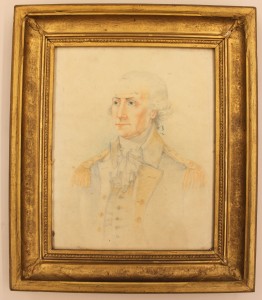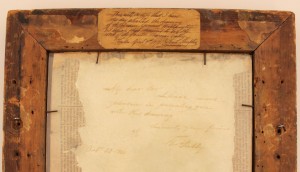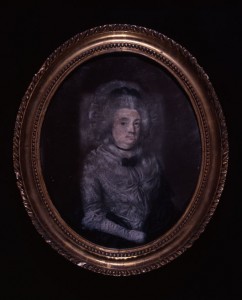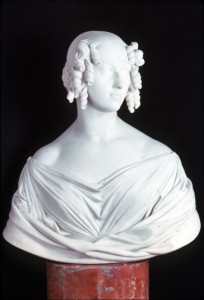Fraud Week on Past is Present concludes today on an appropriately ambiguous note with examples from AAS’s graphic arts collections, most of which are not true forgeries but rather what might be called wishful attributions. These works of art hover perpetually in “the limbo of doubtful pictures,” to quote an earlier AAS librarian. In honor of the collaborative nature of scholarship at AAS, this post is presented in three part harmony.
I. From Jackie Penny, Imaging Rights Coordinator:
Objects fated for the AAS Council Room are typically invested with much prestige. Currently on exhibit is the large collection of Staffordshire Pottery, given to the Society by Emma Deforest Morse in 1913. Also on display is the John Hancock desk and clock, the Isaiah Thomas tea service, a bottle of tea leaves collected after the Boston Tea party, the Mather Family highchair…
In other words – historically powerful objects. So when a crayon and pencil portrait of George Washington in General’s uniform by famous portrait painter Thomas Sully (1783-1872) was given to the Society in 1932 it was slated for Council Room display as well.


This framed bust portrait of the former President [Figure 1] has a manuscript annotation on the reverse that reads: “My dear Sir I have much pleasure in presenting you with this drawing” and is signed “Sincerely your friend Tho[mas] Sully. Oct 23 1860.”
Mounted on the frame itself is an additional manuscript annotation: “This will certifies that I have this day cleaned the drawing of the American General Washington I believe this drawing to be the work of the painter Thomas Sully London April 9th 1878 William Sharpless.”
It was an exciting addition to rather small fine arts collection of the library…
…that is, until it was deemed a forgery, stripped of its designation and banished from the Council Room.
Sully’s signature featured here on the reverse of the framed Washington portrait, was deemed a forgery by John Hill Morgan (1870-1945) two years after it was presented to AAS in 1932. Hill determined the forger was “Doc” Shepard (also known as George J. Shepard OR Ferdinand Danton OR John J. Hughes – a man with many alias names). Morgan uncovered material regarding Shepard as well as other Washington Portraits sold as forgeries in the 1920s and 30s; the resulting collection “John Hill Morgan research files, 1922-1944” is currently at the Frick Art Reference Library.
But the non-Sully portrait?
It was henceforth relegated to the Graphic Arts drawings collection. Not a bad place.
But still not the Council Room.
II. From Lauren Hewes, Andrew W. Mellon Curator of Graphic Arts:

Continuing in the Washington theme, this portrait [Figure 2] was once thought to depict Martha Washington (1731-1802). The portrait has been the subject of much scrutiny since its arrival at the American Antiquarian Society in 1943 since a twentieth-century inscription on the reverse reads ‘Martha Washington, 1787,’ but there is little other evidence to support this identification of the older woman. We do know the previous owners often traveled abroad, which suggests that the pastel may be of European origin. AAS Director Clarence Brigham wrote in 1943:
“[I]t may be of a European lady by an English artist. It is well possible that Mrs. Lowell picked it up in an antique shop and someone penciled Martha Washington’s name on the back because it seemed a likely choice…. All we can do for now is to let the portrait stay in the limbo of doubtful pictures and hope for an eventual solution.”

Similarly, the identity of the subject of this bust [Figure 3] has been in doubt from the time it was acquired on behalf of the American Antiquarian Society in 1881. In that year’s Proceedings, Librarian Edmund T. Barton requested assistance from the members to help identify the subject:
“Attention is called to a marble bust lately received by Mr. Salisbury Jr., from New York, and your judgment requested both as to the sculptor and subject. It was found in a Spanish drugstore, which had previously been used by a marble worker, and represents a lady, probably of the early part of the nineteenth century. Nothing more is known of its history.”
In 1884 the possibility that the bust depicted the writer Lydia Huntley Sigourney (1791-1865) was put forward but was disputed by friends who had known the author in Connecticut. The following year a photograph of the bust was sent to Sigourney’s daughter, Mrs. Francis T. Russell, whose husband responded: “The bust is not of Mrs. Sigourney, we are sure of that.” The elegant sitter, with her carefully coiffed hair and fashionable gown, remains unidentified.
There is, of course, a difference between the outright deceit of a forgery and these examples of wishful thinking. The gaps in history, when information is lacking, often cause people to “fill in” information to create a new reality — one that often reflects modern taste more that the reality of the information that the object presents. When looking at the first woman’s portrait in 1943 they probably thought: it must be Martha — who else could it possibly be? And looking at the bust in 1880, it should be Sigourney — after all, it’s in a prestigious research library now. Sometimes it is better to just honestly say, “we don’t know.” Leave the gaps alone and maybe eventually someone will come along and fill them up!
(You can try your hand at helping us fill in those gaps by examining images of these and other unidentified portraits at the end of the list of sitters in the Society’s illustrated inventory of portraits.)
III. From Elizabeth Watts Pope, Head of Readers’ Service:
To carry on from Lauren’s line of reasoning above, why is it that no matter how lovely a work of art is in its own right, it seems to be human nature to want to dress it up with a famous name? Certainly, one answer is monetary valuation, and the associated values of historical significance and artist merit. Yet the work of art doesn’t change even if you find out it wasn’t done by a famous artist. So why this persistent push to try to connect art to famous people?
Another reason may be because a famous artist or subject gives us a point of contact, a way to connect to a historical artifact. It can help to make history seem somehow less distant and more comprehensible. After all, how can I hold in my head the infinite variation of images from the daily lives of all the eighteenth and nineteenth century women who were washing dishes and reading to their children and dressing up in their finest clothes? But if I think of an eighteenth-century woman and picture Martha Washington, or a nineteenth-century woman and see Lydia Sigourney, that gives me a discrete and understandable package to put my historical ideas into.
Here at AAS, though, we aim to bust open those narrow frames. We don’t want to just talk about famous people or valuable art. The American Antiquarian Society has always collected as indiscriminately as possible (within the scope of our collection). Here you will find the fakes, the unknowns, and the copies identified as such and sitting on the shelf alongside the famous and the first editions.
IV? There’s room for your voice too!
We hope you have enjoyed this week of posts exploring this underside of the archival world, and we would love to hear your thoughts on the implications of fraud in history. Hopefully we have armed you with some tools so you can be on the look out for forgeries, funny money, pirated copies, and falsely-identified works of art. Let us know what you find!
